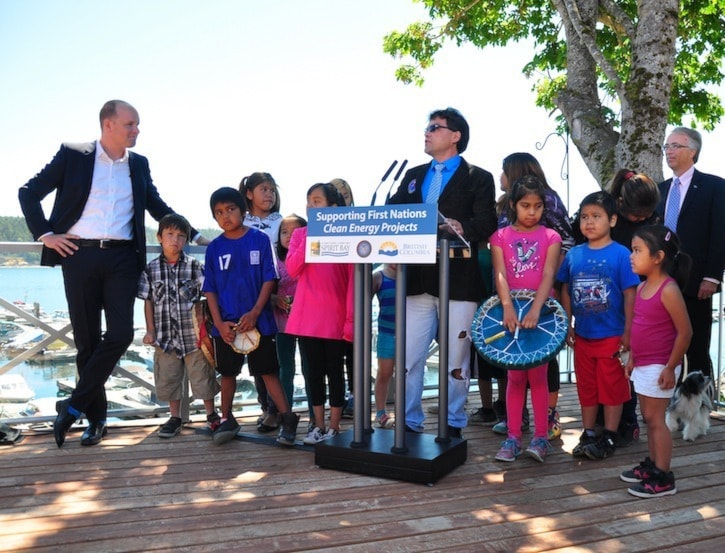Green and renewable energy is all the rage these days, for good reason; communities can flourish at minimal expense to their residents and to the environment — what’s not to like?
Now, East Sooke’s Beecher Bay First Nations Sci’anew (Cheanuh) community is jumping on that wagon as well, thanks to a $400,000 grant from the B.C. government’s First Nations Clean Energy Business Fund.
The bold new energy project is set to use ocean thermal energy in order to heat the first 50 homes of a new and modernized town called Spirit Bay — the idea being that heat is extracted from the ocean using heat exchangers and pumps and is then delivered to the development via a district heating system.
The proposed community — which is expected to grow to 600 homes within the next 10 years — will include a gas station and grocery store in its commercial centre, and a spa resort will use natural hot springs fuelled by the ocean.
Present at the project’s official unveiling last week was Sci’anew First Nations Chief Russ Chipps, the honourable John Rustad, Minister of Aboriginal Relations & Reconciliation, and Judith Sayers, Director of Clean Energy BC & First Nations Strategic Advisor. All guests were greeted by the captivating and traditional singing by Sci’anew youth.
“For us to be able to set up a utility to service the homeowners out at Spirit Bay creates a long and sustainable means of revenue for the band,” said Kris Obrigewitsch, executive director of the Trust for Sustainable Development and the project’s lead developer. “To do so, producing global energy is no better way to make money. If you can do it green, that’s all the best.”
The way the ocean thermal system works is a heat exchanger will first be installed into the water, then a “district loop” connects all the pumps from each respective home to a heat exchanger. Two lines; one cold, one warm will be set up. The warm water coming through the ocean is circulated through the heat pumps where they draw energy out of it for the homes to heat them up; the pumps then dump the cold water back into the cold line and circles it back through the heat exchanger in the ocean which warms it back up again.
And unlike other renewable sources of energy, such as solar or wind, there are no large moving parts or intensive infrastructure required for the job; Obrigewitsch said that at the end of the day, it’s all pipes and pumps, all of which have a lifespan of 15 years or so.
“What you end up with is renewable thermal energy in homes brought from the warmth of the ocean, and we end up doing it for a price that we’re providing lower than if you got through BC Hydro and Fortis for that same thermal heating,” he said.
None of this however, would of even begun if it wasn’t for the building of a healthy relationship in the first place between the TSD and the Sci’anew First Nations, Obrigewitsch added.
“”We came out with a goal that was set out by the band, they wanted to have more biodiversity and more sustainability than what was out here originally,” he said, adding that the band created a 100-acre economic development zone, which is mainly comprised of residential/commercial land, as well as 30 acres of industrial land. The marina, which is fully owned by the band however, is entirely separate from the development.
It goes beyond just drilling a hole, or filling a quota in some office though. For the Sci’anew First Nations, the Spirit Bay project is also a more natural transition to modern technology that maintains the spirit of local tradition, noted Cheanuh First Nations Chief Russ Chipps.
“We’re the Cheanuh, the salmon people, so taking energy from the ocean is natural to us because it creates this holistic, healthy energy out here for us,” he said. “It’s 21st century technology that is based on traditional use of the water. We use the water for everything: food, medicine, and now power.”
“It’s really not about the energy, or about the houses, the development, or me, or anybody else, but these kids,” Chippssaid. “They’re future. They’re change. For as long as we have the strength to dream, we can spread our wings and fly.”
With construction already in full swing, a lot of the infrastructure will be done by December this year, Obrigewitsch added — the first 50 homes are expected to be built within the next year and a half.
“It really sets the stage for what could be a way of the future for many communities along the seaside,” said John Rustad, Minister of Aboriginal Relations & Reconciliation. “I look forward to seeing this project, look forward to the opportunity in what it will present, the revenue that will be created for the band, and for building a future for the children you see here, because ultimately, this is what we’re trying to do.”
With clean energy projects ramping up all over the province, Judith Sayers, Director of Clean Energy BC & First Nations Strategic Advisor, said new job opportunities for First Nations will be on the rise as well.
“These 21 projects being build throughout British Columbia, 25 per cent of the jobs in construction will go to First Nations,” she said. “The clean energy industry really takes advantage of its relationships with First Nations to bring positive benefits, that’s what this project represents.”
To date, $3.5 million has been approved for First Nations equity investments for eight clean energy projects through the First Nations Clean Energy Business Fund. B.C. has also entered into 36 clean energy revenue-sharing agreements with First Nations, including 10 new revenue-sharing agreements this spring.
